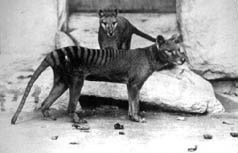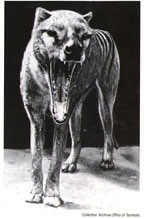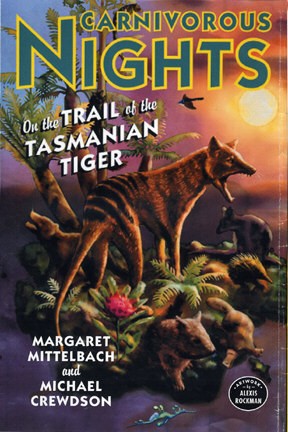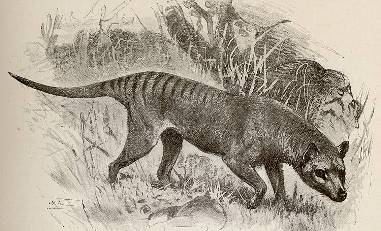70 Years: Thylacines Still Rule!
Posted by: Loren Coleman on September 6th, 2006

The 70th anniversary of the Thylacine’s extinction is September 7th! Do they still walk among us? Did Steve Irwin see one in Tasmania?
The last captive thylacine died in the Hobart Zoo on September 7, 1936. Today in Australia, the day is now known as “Threatened Species Day.” Ten years ago it was known as “National Thylacine Day.”

The last thylacine (third one pictured below) was captured in 1924, with its mother and siblings, in Florentine Valley, Tasmania. In 1933, this last thylacine, a female, was sold to the Hobart Zoo. (Whether or not it was ever named “Benjamin” is a subject of much debate.) The world’s last captive then died in that zoo three years later. In the same year, 1936, or in 1938, by some accounts, the Tasmanian tiger was added to the list of Protected Wildlife. Finally, 50 years after the death of the last captive, in 1986, the thylacine was declared extinct by international standards.
But sightings in the wild persist. Do they live today out in the forest bush of Tasmania (almost 400 sightings), on mainland Australia (over 4000 sightings), or in the rainforests of New Guinea (a handful)?



As mentioned earlier this week, the late Steve Irwin went to Tasmania and filmed an episode of “The Crocodile Hunter” about the search for the Thylacine or Tasmanian Tiger. He reportedly may have captured footage of a Thylacine. (Read more on this angle here at Steve Irwin #1 and Steve Irwin #2.)

The Thylacine today is the subject of much discussion and searching within cryptozoology. The cryptid, for example, is the subject of one of the best cryptozoology books of recent years, Carnivorous Nights: On the Trail of the Tasmanian Tiger, shown here with well-known artist Alexis Rockman’s cover, in all of the spectacular colors of the Tasmania rainforest.

Many locations have good museum collections educating the public on the Thylacine, especially in Australia and Tasmania. In the United States, in the traveling exhibition, at Bates College’s Museum of Art and Kansas City’s H&R Artspace, Cryptozoology: Out of Time Place Scale, many exhibits are tied to the thylacine, including more Rockman paintings, a full-size steel thylacine sculpture by Rachel Berwick, the continuous running of the last footage of the Hobart Zoo thylacine, Tasmanian tiger popular culture souvenirs from Jeffrey Vallace’s collection, and a 2001 footcast of an allegedly post-extinction Thylacine encounter and other items from my cryptozoology museum.
Will evidence of the Thylacine be found in the next decade? In 1984, Ted Turner offered a $100,000 reward for proof of the continued existence of the Thylacine. It went unclaimed by the time it was withdrawn at the end of the 20th century. Reportedly still current, an offer of $1.75 million (probably Australian dollars) has subsequently been offered by a Tasmanian tour operator, Stewart Malcolm, but this is also unclaimed today.
Click on this 1910 image for a full-sized version
Thanks to the one-sentence reminder from Chris Rehberg in Sydney about this anniversary, which stimulated me to write the above and share these images with you. Rehberg has likewise decided to author his own reflective moment about this event at “70 years extinct! Or is it?”
^^^^^^^Later^^^^^
Xeni Jardin at Boing Boing acknowledges this story, in “Get ready for National Thylacine Day, Sept. 7!”. And as she learned, the Thylacine (Thylacinus cynocephalus) is not a feline, but a “tiger” only in looks. It’s a dog-sized carnivorous marsupial.
About Loren Coleman
Loren Coleman is one of the world’s leading cryptozoologists, some say “the” leading living cryptozoologist. Certainly, he is acknowledged as the current living American researcher and writer who has most popularized cryptozoology in the late 20th and early 21st centuries.
Starting his fieldwork and investigations in 1960, after traveling and trekking extensively in pursuit of cryptozoological mysteries, Coleman began writing to share his experiences in 1969. An honorary member of Ivan T. Sanderson’s Society for the Investigation of the Unexplained in the 1970s, Coleman has been bestowed with similar honorary memberships of the North Idaho College Cryptozoology Club in 1983, and in subsequent years, that of the British Columbia Scientific Cryptozoology Club, CryptoSafari International, and other international organizations. He was also a Life Member and Benefactor of the International Society of Cryptozoology (now-defunct).
Loren Coleman’s daily blog, as a member of the Cryptomundo Team, served as an ongoing avenue of communication for the ever-growing body of cryptozoo news from 2005 through 2013. He returned as an infrequent contributor beginning Halloween week of 2015.
Coleman is the founder in 2003, and current director of the International Cryptozoology Museum in Portland, Maine.











One question that’s bugging me: Are videos of “Ben” the only known film footage of an actual thylacine?
If so, they would have been taken sometime between 1933 and 1936, right?
However, according to this website, there exists another footage made sometime prior to 1931.
I think there is a good chance they may still exist. But if Steve got one on film he probably would have went public with the news right after he taped it. But you never know.
If there ever was a creature to be discovered alive after being labled extinct, it would be the thylacine. Such a strange looking creature. They must be able to unhinge their jaw, also their back legs have a longer travel to the elbow than any other animal I’ve seen. I wonder how they used these unique characteristics to their advantages.
Back in 2000, a friend of mine visited Australia and Tasmania. While he and his wife were on a tour of the rural areas of Tasmania, he struck up a conversation with the tour guide. Dave was telling the guide that he had a friend (me) who was fascinated by Thylacines, and believed they might still survive in the wild. The guide told him that he knew for a *fact* they still existed, and in fact had seen several of them, himself. He said that there was a sort of unspoken agreement to keep their sightings quiet – to leave the animals in peace.
Welcome to people hooking up with us for the first time via Boing Boing. I’ve added an update about that item above.
Peter – the same website shows a very short clip from London Zoo also.
There is also possible post-extinction footage from 1973.
I am in discussions with the National Archive of Australia about any film footage available from them. They have informed me that everything they have is what’s already available, but thylacine footage has appeared in numerous other film (ie documentary) pieces – so there may well be some interesting stuff in the Archives which isn’t as commonly recognised.
Chris.
Hi Loren, folks,
It’s ironic that we’re talking about the thylacine today : two weeks ago, on my trip to Québec city, I was exstatic to have found, in the old Laval University’s museum, a stuffed thylacine! It’s as close as I’ll probably ever get to a real one, but it was a thrill to have finally seen for myself how the hide of one looks like. If anyone cares to see the spiffy thylacine I glimpsed, visit my website (my site is French; sorry for any inconveniences).
Cheers
there have been footage of plenty of “extinct” animals throughout film history, but most people wouldn’t believe it unless the thing bit them (and that looks like quite a bite).
There are some -very- interesting frames in that video. But I want to watch a video of a dog and a fox running, just to be sure.
At 00:00:04, there is a particularly kangaroo-like moment, as there were one or two earlier in the short video as well.
It sure is a shame that there wasn’t as much interest in them being alive at the time when they were being killed off and vacated from their habitat. At least not enough to keep them from dissappearing. That being said, I think it is perfectly feasible that they could still be a small population out there. From what I understand, Tasmania has a large amount of remote wilderness for being such a small island.
After viewing the short films, I am struck by the semi-plantigrade rear feet of the thylacines. That is the answer to a question that was asked here about the length of the hindlimb between the heel and the knee. In most accounts that I have read of the thylacine, it was pointed out that the hind feet are semi-plantigrade, and also that then thylacine was capable of jumping like a kangaroo when pursued at speed.
But another interpretation has occurred to me. That semi-plantigrade rear stance is also very similar to that of the fossa, (Cryptoprocta ferox),an animal closely related to cats but now considered to belong to the viverrids. In the case of the fossa, the plantigrade rear feet seem to be an adaptation to a largely arboreal way of life. All species of true cats have fully digitrade feet, but, as is clearly described and beautifully illustrated illustrated in Turner & Anton’s wonderful book _The Big Cats and Their Fossil Relatives_, even the fully digitrade cats resort to a plantigrade stance when leaping into and through trees. Could the thylacine’s unusual hind limbs be an adaptation for hunting in trees? They seem to have reared up onto their hindlimbs routinely, and their somewhat long, supple bodies are also characteristic of animals that spend time in the trees.
Another thing that I noticed in the thylacine films is their very flexible wrists. They appear to have been able to rotate their wrists much more than can canid animals. A grasping, rotatable forepaw is also a characteristic of arboreal animals.
I am not suggesting that thylacines lived in trees, but I do wonder if they may not have spent quite a lot of time in them. After all, they were Tasmanian animals, and Tasmania is heavily forested and was even more so before European colonization. Many of the wallabies that thylacines hunted were tree dwellers. It seems logical to conclude that the adaptations possessed by thylacines, which are common to other predators that do a lot of tree climbing, evolved for moving about in trees. They could be ground-dwelling predators that also do a lot of hunting in or from trees.
If thylacines DO spend at least part of the time in trees, that could partly explain why sitings are so rare: we aren’t looking UP! Has anyone read or heard anything to indicate that thylacines may hunt in trees as well as on the ground?
Another thing: in the recent short film of the running animal, the critter in the film seems to have the semi-plantigrade hind limbs. That sort of leaping gallop is also sometimes seen in German Shepherd Dogs that have weak hocks. Sometimes the dogs are so over-angulated in the rear that the hind feet are almost flat on the ground. When these dogs move at the trot the gait looks normal, but when they try to gallop, they have a bouncing leap similar to the animal in the film. Whatever that animal is, It does look like it has those semi-plantigrade hind feet.
There have been so many large animals that were hunted to the verge of extinction, where a remaining vestigal population kept the species going. These include the American bison, the Florida panther, the red wolf, and even the cheetah. By some accounts, even modern humans endured a population bottleneck. I see no reason why the thylacine could not have survived a similar population crash.
Well I finally decided to register lol. I have been following this site for a few months now and it is my favorite cryptozoology site! The stories are interesting and varied and there is so much information being added daily. The comments are thoughtful and are enjoyable to read.
The 7th of September 2006 represented the 70th anniversary of the animals extinction in captivity and I really hoped conclusive evidence of its continued existance in the wild would have been found by now. I’m not that surprised that it hasn’t but I still fel that there is a good chance that it is out there.
Tasmania is a large island. It is about the size of Ireland but only has 1/10th the population (and Ireland has plenty of space) and there are still large areas of wilderness that remaine pretty much untouched and unsettled. The animal could easily exist in these remote areas and go undiscovered. So my moneys on its continued existance. Just hope it will be proven once and for all sometime soon!
It is good to see such well reasoned logical thinking applied to the continued existence of the Thylacine.
Scrutiny of the 1973 film appears to me to rule out the european fox and any type of cat as the mystery animal while most dogs do not possess a similar running style. It would appear sensible to compare limb/tail lengths and stride patterns etc in order to try and resolve this sighting. The comments above concerning possible tree climbing for hunting appear valid.
The tree theory is interesting, but I would think they would still have been sighted. New species of birds get discovered that are smaller than a thylacine. something that large would be spotted be it in a tree or on the ground. The vegetation would be so thick that looking on the ground would be no easier, I’d think. Is there any documentation of this tree dwelling aspect of Thylacines? Personally, I would say they might have evolved from a tree dwelling carnivore, but no longer do so based on what I understand about them and the documentation I have seen. It’s a good theory, though. Would be very interesting if it turned out to be true.
Great points, kittenz.
However, I have to say – after learning about the thylacine informally for several years, and reading a handful of books, I have found no references to thylacines being tree dwelling.
At the same time, there are references to thylacines being able to do quite decent “standing jumps”. They did this (onto walls) whilst in zoos.
I recently had a long online discussion about one of Australia’s extinct marsupial carnivores (although there are those who believe it may not be extinct) – named thylacoleo.
Thylacoleo has received a one hour documentary screening here in Australia about 2 weeks ago, and the conclusion is that this predator was a tree dweller.
In many respects, thylacoleo had the physiology to climb trees in a similar way that a possum might, and the speculation is that thylacoleo was in fact a herbivore turned carnivore.
As mentioned, there are people here who believe thylacoleo lives today. Those who claim to have seen it say that its appearance is identical to a panther (in body shape and colour), but with a possum’s face.
DT40 – you mentioned scrutiny of the 1973 footage. I have spent two lengthy nights putting together a piece about exactly that. I am not yet finished though, so it is not yet online. I’ll do my best to finish it off tonight and make sure to let you all know.
The analysis looks at various frames from the 1973 footage, 1930s footage and footage of greyhounds.
Chris.
I am not suggesting that thylacines actually lived in trees; I know that there is evidence that they sometimes denned in caves or rock overhangs. But I sure would like to know whether there are any accounts of thylacines hunting in trees. Their physiology seems so well suited for arboreal activity.
My passion is actually the cat family, from the earliest known cat-like fossils to the modern cats with which we share the Earth. In my studies, I came across this wonderful book, The Big Cats and Their Fossil Relatives, by Alan Turner and Mauricio Anton. In chapter 4 there is a discussion of the stability of a plantigrade stance and the advantages of that stance for animals that climb trees. Turner also points out that a wide range of flexibility in the wrists and ankle joints is important because it allows the feet to adjust to irregular surfaces. He goes on to note that a long, flexible back, such as those found in primitive (and presumably tree-climbing) carnivores indicates that the animal possessing it would likely be an able tree climber. There is also discussion concerning the differences in hunting techniques between animals exhibiting these attributes, and animals such as wolves, which hunt mainly by coursing. The book is beautifully illustrated by Mauricio Anton, and on page 109 of my copy there is a depiction of a cat preparing to spring from a tree branch, which shows how even a digitrade cat uses its entire foot for stability in the trees. Viewing the short films of the thylacine, I was struck by some their similarities to the fossa, a completely unrelated placental mammal. When unrelated animals evolve similar features, it is usually because they share similar lifestyles.
Even the thylacines’ wide gape, long teeth, extremely powerful bite, and reputed savageness when fighting could be advantageous to a tree-climbing hunter. If you are a Tassie Tiger, on a tree branch, say, twenty or thirty feet above the forest floor, snapping at a wallaby or a bird that might escape in an instant, it pays to make that first bite count: you might not get a second chance to secure that prey, and you want it dead quickly so you don’t have to struggle with it and chance falling and injuring yourself.
My point is: people seem to have formed a mental image of the thylacine as a courser, like a wolf. One of its most common names is Tasmanian Wolf, because it superficially resembles a dog. But looking more closely, and given its physiology, and the fact that it has so many characteristics of tree-climbing animals, I don’t believe that the concept of it having a wolf-like lifestyle is very accurate. We need to throw away the term “Tasmanian Wolf”. If we are going to nickname it, Tasmanian Tiger is more appropriate. We need to broaden our thinking about thylacines to include the possibility that they may have been, or may indeed be, at least partly arboreal. Tasmania is a large island, and for thousands of years the thylacines lived there in a mature forest environment. Why would they have evolved features so well suited for tree climbing if they did not need to climb trees?
Their long, flexible backs, their semi-plantigrade feet, their flexible wrists, their propensity for vertical leaping – even their long teeth and wide gape – seem to indicate that they would be very capable tree climbing hunters. Why would it have evolved such adaptations, if not to utilize them?
I suppose an argument could be made that the thylacine has these characteristics due to its having evolved from tree-dwelling animals, and that it does not necessarily share that affinity for trees with its ancestors. After all, lions and tigers evolved from tree-climbers, and they still have those characteristics, but they do not regularly climb. But lions and tigers do not climb, as adults, because they are simply too heavy to be able climb safely. Thylacines are not too heavy to be efficient climbers. They appear to have had a body mass similar to that of the mid-sized cats such as small pumas or leopards or caracals – all of which very efficient at hunting in trees. Once you broaden your view of the thylacine to include the possibility, it is easy to imagine them lying along a large branch, or leaping up into the trees in pursuit of prey. Of course, the same adaptations that facilitate tree climbing would also be useful for hunting among rock cliffs, etc.
It’s too bad that thylacines disappeared before detailed studies of them could be done. I hold great hope that they are out there, and that the species can yet be saved.
The analysis of the 1973 footage by Liz and Gary Doyle in South Australia is now available.
Kittenz – I wouldn’t say that there was an absence of detailed study. Firstly, biologists of the day did study and describe the species.
Robert Paddle’s book “The Last Tasmanian Tiger: The History and Extinction of the Thylacine” looks in detail at how scientific and public perceptions of the animal formed and changed from its discovery to the present. Paddle’s work is based on a swathe of recorded documents – some scientific, many not (such as letters, newsletters, newspapers).
Apart from the works Paddle reviews, Paddle himself brings new insights into the hunting, migration and family/dominance behaviours of the species which have been acknowledged as useful new information on the species.
I’d recommend the Paddle book for a history of the thylacine and Col Bailey has also written a book titled “Tiger Tales”, of stories gleaned from first-hand witnesses of the animal (typically trappers) as well as post-extinction witnesses. The trapper accounts in particular contain numerous references to species behaviour also.
Chris.
I grew up in Tasmania and around the early 1980’s I believe I had a Thylacine sighting.
I was driving home late at night along a stretch of road called Old Beach Road, I think? that’s what it was called, it is a stretch of road cut from cliffs that runs between Risdon Vale and Lindisfarne, or there abouts. I haven’t lived there for a long time. Anyway, the road was very isolated and had no street lights as there weren’t many houses etc around. I was giving a friend a lift home, he lived in Risdon Vale. As we were driving along, an animal which we initially thought was a greyhound came into view in the cars headlights. As we drove past it my mate made comment that he thought it looked like a Tasmanian Tiger and he commented that he thought it had the distinctive strips and hindlegs and tail. It certainly had that look to it. Excitedly we pulled the car over and turned around, but unfortunately we were unable to locate the animal again.
Also, about a year later, we had a mutal friend who scored himself a job with the Tasmanian Wildlife Service and one day we got to talking about the Thylacine and he told us that he had seen proof that they knew where there were pockets of the animals but it was all very hush hush as you would imagine. Whether he was yanking our chains or not well who knows? Yet it sounded plausible.
Chris
Very good analysis by youcantryreachingme which to my mind strengthens the case for the 1973 Doyle film being a thylacine. While not certain it seems possible to discount virtually all the other contenders.
I just cannot see a dog running and have discounted both fox and cat. Do we know the circumstances relating to the sighting and what the Doyles comments on the film’s subject were.
Good sighting info Chris (Snoggett). See my earlier comments for some links to ARFRA and Col Bailey – they would both be interested in the information.
You might also be interested in tasmanian-tiger.com as they have a series of Tasmanian sightings from the 1980s – 1990s documented on their site.
DT40 – I know very little about the Doyle footage; in fact – pretty much the only thing I know is what there is at the thylacine museum.
However, I have recently come across a thylacine/fox comparison which I plan to look at in more detail. In this case, the fox is missing about 70 percent of its fur and looks remarkably like a thylacine – more so from a distance. You might find it strengthens the case for the Doyle footage showing a fox.
In addition, I have received a new version of the Doyle footage which has had the subject (animal) stabilized and centered. It is also a higher resolution image and leads me to agree with Campbell that there are in fact several frames which seem to indicate the animal was striped. Exact details are yet to follow at Where Light Meets Dark, but in the meantime, I have added a little information about how it is that Klaus and Birgit ended up tourists in Tasmania without really knowing much at all about their destination – let alone the tiger.
Thanks Youcantryreachingme,
I await your further analysis. I may be completely wrong but I cannot see the Doyle animal as a fox. I am only conversant with european foxes being situated in England but I see plenty of them running about and they seem to run in a completely different manner. In addition the length of their tales would appear to be different.